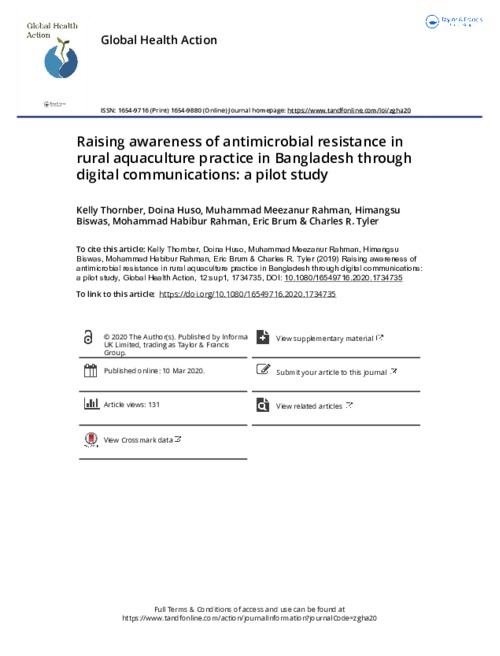Raising awareness of antimicrobial resistance in rural aquaculture practice in Bangladesh through digital communications: a pilot study

Citation
Thornber, K. et al. (2020). Raising awareness of antimicrobial resistance in rural aquaculture practice in Bangladesh through digital communications: a pilot study. Global Health Action, 12: 1734735.
One of the key strategic objectives of the World Health Organisation’s global antimicrobial resistance (AMR) action plan is to improve public awareness and understanding of this issue. Very few AMR awareness campaigns have targeted the animal production sector, particularly in low- and middle-income countries (LMICs) where rural communities can be geographically difficult to access via traditional face-to-face community engagement methods. Aquaculture is a major food production industry in Bangladesh and across Asia, an area which poses a significant risk to global AMR dissemination. In this pilot study, we sought to investigate the potential for digital communication materials to rapidly and effectively communicate AMR messages to rural aquaculture farmers in Bangladesh. Working with stakeholders from the Bangladesh aquaculture industry, we developed a 4-minute digital animation designed specifically for this audience and assessed its capacity to engage and communicate AMR messages to farmers. We then conducted a small-scale social media campaign, to determine the potential for rapidly disseminating AMR awareness materials to a large audience across Bangladesh, where there is an extensive 4 G internet network and an ever-increasing proportion of the population (57% as of December 2019) have mobile internet access. Thirty-six farmers were surveyed: all of them liked this method of communication and 97% said it would change the way they use antibiotics in the future. Through the social media campaign, the animation received 9,100 views in the first 2 weeks alone. Although preliminary, these results demonstrate the huge potential for digital communication methods for the rapid and widespread communication of AMR awareness materials to rural aquaculture communities in Bangladesh and across Asia. Our results support the need for more research into the most appropriate and effective content of AMR awareness campaigns for aquaculture communities and question the need for explaining the science underlying AMR in such communication materials.
Permalink
Date Available
Type
Publisher
Countries
ISSN
1654-9716
Copyright
CC-BY-NC-ND-4.0
Research Themes
Topics
Language